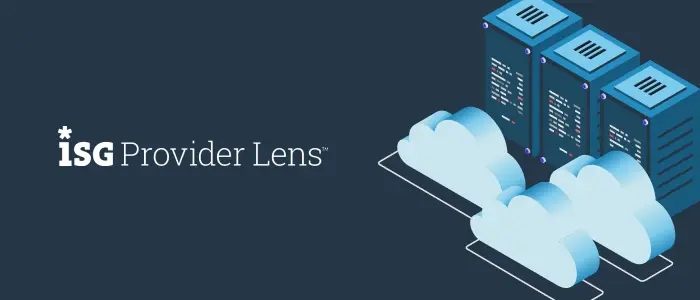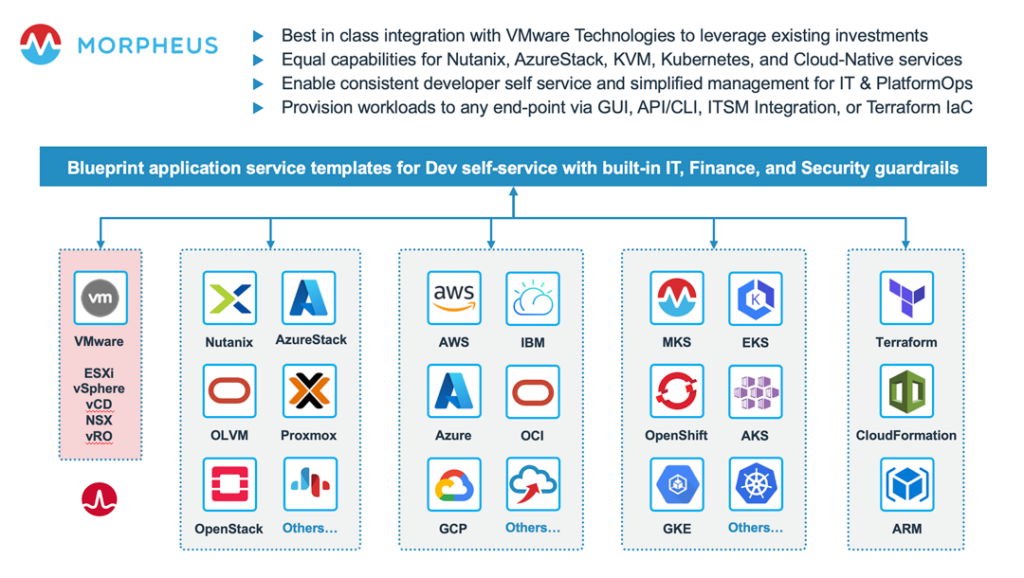
The Broadcom acquisition of VMware concluded in November 2023 and the reality of the impact is seemingly worse than many had feared. Notorious heartbreakers, Broadcom was quick to break up many aspects of VMware including price increases, license changes, and service provider program cancellations to name a few.
We hear everyone’s concerns loud and clear; it’s important to mitigate the risks and future-proof your IT landscape in the wake of these extreme changes. As with any relationship, considering the pros and cons is important before you pull the plug.
At its core, VMware is a hypervisor company, so it makes sense to start there, but it’s equally important to think about how you are going to migrate and orchestrate across VMware and whatever comes next. Clearly, Aria Automation (aka vRrealize Automation) is not an option if you are looking at non-VMware hypervisors.
VMware Hypervisor Alternatives
One of the main use cases for Morpheus is to turn on-prem hypervisors into a true private cloud experience. With over 1M VM’s provisioned, we have an informed perspective on what’s getting traction.
VMware still makes up the bulk of the on-prem hypervisor market but we’ve seen a significant uptick in the alternative hypervisors that we equally support including:
The Broadcom-VMware acquisition is also causing organizations to look at their mix of on-prem and public cloud; platforms like AWS, Azure, and GCP offer a scalable and flexible alternative to on-premises virtualization by letting you run VMs in the cloud.
Shameless Morpheus plug here… we support all of the above so if you want to blueprint the applications in your service catalog and then provision VMs into VMware, AzureStack, Nutanix, KVM, or any public cloud you’ve come to the right place.
Looking beyond virtualization towards cloud-native alternatives
In the wake of the Broadcom acquisition of VMware, many organizations are accelerating away from traditional virtualization towards containerization and Kubernetes (K8s). Why?
Unfortunately, open-source options like K8s don’t have the same simplicity and tooling as VMware. Like OpenStack, many organizations started down the K8s path only to realize it can be complicated to set up and manage. Many larger enterprises are also now facing Kubernetes sprawl with different teams picking up and running with the K8s distro of their choice, leaving IT Ops to pick up the pieces.
Morpheus provides a built-in K8s distribution and cluster management utility for free as part of the platform including the ability to customize and add your custom packages. You can also connect to your existing Kubernetes clusters and provisioned cloud-managed K8s (AKS/EKS/GKE) to provide consistent management and governance across heterogeneous K8s estates.
For those who want to skip the underlying stack completely, re-factoring applications to take advantage of cloud-native options enables offloading of operational responsibilities. These options include PaaS services like RDS and DynamoDB as well as cloud Functions from the major hyperscale providers.
Yes, I know we sound like a broken record at this point… Morpheus also lets you simplify provisioning and governance of cloud-managed PaaS and Functions leveraging our blueprint integration with DSLs including AWS CloudFormation, Microsoft ARM, and Hashicorp Terraform (HCL). It really is the best way to straddle legacy and cloud-native deployment patterns.

Mitigating hypervisor risk with unified orchestration from Morpheus
There’s a lot to consider when weaning yourself off of VMware. The need for change is imminent as your ELA renewal inches closer – but it’s more complicated than many people realize.
The good news is that Morpheus has helped dozens of the largest companies on the planet reduce their dependency on VMware and embrace a unified cloud operating model across on-prem and hyper-scale environments. We’ve learned a bit along the way:
One of our favorite poster children is global pharmaceutical leader AstraZeneca. They were ahead of the curve and traded in vRealize Automation for Morpheus a few years ago. Since that time, they’ve utilized different on-prem hypervisors and public cloud services. They continue to see greater developer agility, increased workforce productivity, and millions of dollars in savings.
Adopting a centralized orchestration platform that manages diverse infrastructure components, prioritizes enhanced automation, and supports hybrid cloud deployments is crucial to thinking ahead, even despite the Broadcom shroud. Whatever you decide to do, Morpheus will be there to simplify and streamline, and whatever level of breakup ensues, it won’t be as heart-wrenching as originally feared.
To help you evaluate your options we’ve developed a 90-day risk mitigation program that is consultative, affordable, time-bound, and services-led. Yes, there is a unified software platform at the end of the rainbow, but we’d like to start by discussing your mitigation strategy, inviting you to a hands-on lab, and letting our experts share lessons learned from successful vRA migrations and private cloud implementations.
Worst case, you can honestly tell your CIO you are actively working on a risk mitigation plan and get some leverage over Broadcom when that ELA renewal comes around. Best case, you take back control of your workloads, leapfrog your competitors, and enable a hybrid cloud platform operations strategy.